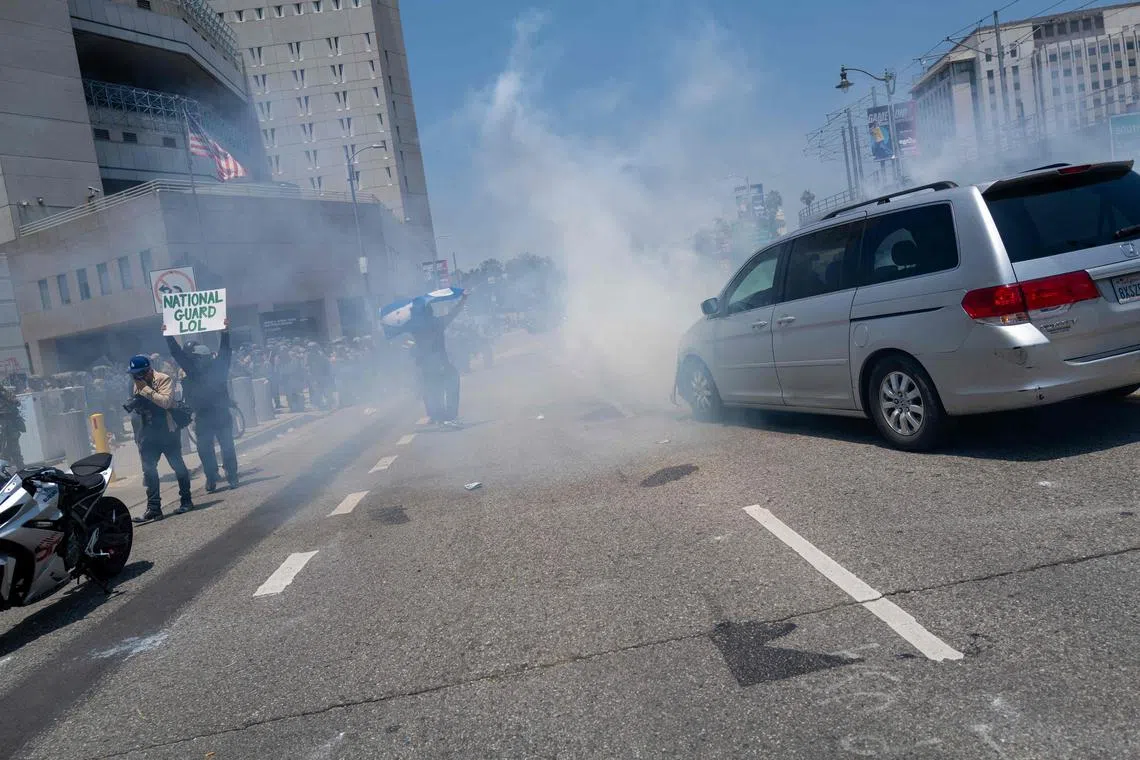Trump deploys Marines as tensions rise over Los Angeles protests
Sign up now: Get ST's newsletters delivered to your inbox
Follow topic:
LOS ANGELES - US President Donald Trump on June 9 ordered active-duty Marines and 2,000 more National Guard troops into Los Angeles, vowing those protesting immigration arrests would be “hit harder” than ever.
The extraordinary mobilisation of 700 full-time professional military personnel – and thousands of National Guard troops – came on the fourth day of street protests triggered by dozens of immigration arrests in a city with huge foreign-born and Latino populations.
Mr Trump said on June 10 that only his deployment of Marines and other soldiers was preventing the city from “burning to the ground”.
“If I didn’t ‘send in the troops’ to Los Angeles the last three nights, that once beautiful and great city would be burning to the ground right now,” he posted on Truth Social, claiming that the so-far sporadic street unrest posed the same threat as a recent wildfire that destroyed entire neighbourhoods in the city.
California Governor Gavin Newsom slammed the move, posting on X that US Marines “shouldn’t be deployed on American soil facing their own countrymen to fulfil the deranged fantasy of a dictatorial president. This is un-American”.
The deployment came after demonstrators took over streets in downtown Los Angeles on June 8, torching cars and looting stores in ugly scenes that saw law enforcement responding with tear gas and rubber bullets.
The June 9 demonstrations unfolded largely peacefully, however, after weekend protests triggered by dozens of arrests of people the authorities said were illegal migrants and gang members.
“Pigs go home!” demonstrators shouted at National Guardsmen outside a federal detention centre.
Others banged on the sides of unmarked vehicles as they passed through police containment lines.
One small business owner whose property was graffitied was supportive of the strong-arm tactics.
“I think it’s needed to stop the vandalism,” she told AFP, declining to give her name.
Others were horrified.
“They’re meant to be protecting us, but instead, they’re being sent to attack us,” Ms Kelly Diemer, 47, told AFP. “This is not a democracy any more.”

The deployment came after demonstrators took over streets in downtown Los Angeles on June 8.
PHOTO: REUTERS
In the nearby city of Santa Ana, about 50km south-west of Los Angeles, law enforcement fired tear gas and flash-bang grenades on protesters chanting against the Immigration and Customs Enforcement agency as darkness fell.
‘Hit harder’
Mr Trump, speaking in Washington, branded the protesters “professional agitators and insurrectionists”.
On social media, he said protesters spat at troops and if they continued to do so, “I promise you they will be hit harder than they have ever been hit before”.
Despite isolated and eye-catching acts of violence, which included the torching of several Waymo cars on June 8, officials and local law enforcement stressed that the majority of protesters over the weekend had been peaceful.
Schools across Los Angeles were operating normally on June 9, while the rhythms of life in the sprawling city appeared largely unchanged.

A demonstrator holds a placard as protesters clash with law enforcement on June 8.
PHOTO: AFP
Contrasting Mr Trump’s descriptions of the protests, Mayor Karen Bass said: “This is isolated to a few streets. This is not citywide civil unrest.”
Los Angeles police chief Jim McDonnell said the local authorities were able to control the city.
“The introduction of federal, military personnel without direct coordination creates logistical challenges and risks confusion during critical incidents,” he told reporters.

The National Guard, police and protesters stand off outside of a downtown jail in Los Angeles on June 8.
PHOTO: AFP
At least 56 people were arrested over two days and five officers suffered minor injuries, Los Angeles Police Department officials said, while about 60 people were arrested in protests in San Francisco.
Protesters also scuffled with police in New York City and in Austin, Texas, on June 9.
Police made several arrests after around 100 people gathered near a federal building in Manhattan where immigration hearings are held, an AFP reporter there saw, while law enforcement fired tear gas on dozens of protesters in Austin, NBC affiliate KXAN reported.
Mr Trump’s use of the military was an “incredibly rare” move for a US president, Professor Rachel VanLandingham from the Southwestern Law School in Los Angeles and a former lieutenant-colonel in the US Air Force, told AFP.
The National Guard has not been deployed over the head of a state governor since 1965 at the height of the civil rights movement.
US law largely prevents the use of the military as a policing force on home soil, absent an insurrection.
This is for good reason, Prof VanLandingham said, explaining that troops such as the Marines are trained to use lethal force, as opposed to domestic peacetime law enforcement.
“What does ‘protect’ mean to a heavily armed Marine who has not/not trained with local law enforcement, hence creating a command and control nightmare?” she told AFP via e-mail.
The Pentagon said late on June 9 that Mr Trump had authorised an extra 2,000 guardsmen, seemingly on top of the 2,000 he deployed over the weekend.
Around 1,700 guardsmen had taken up positions in Los Angeles by late on June 9, the US Northern Command said on X. AFP

